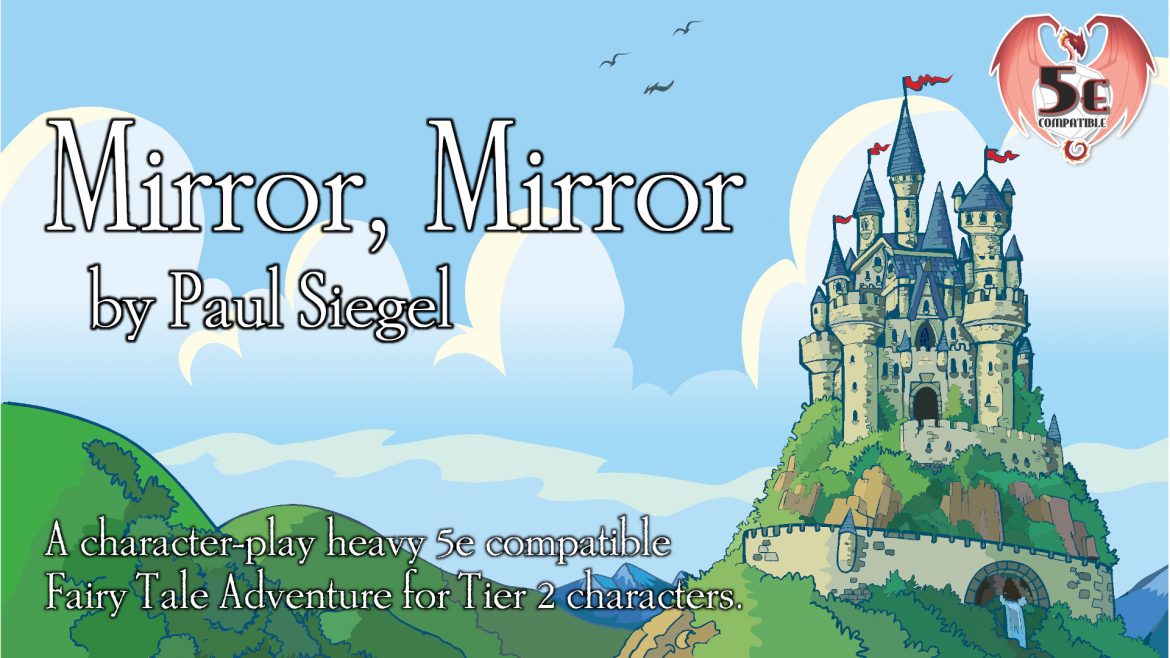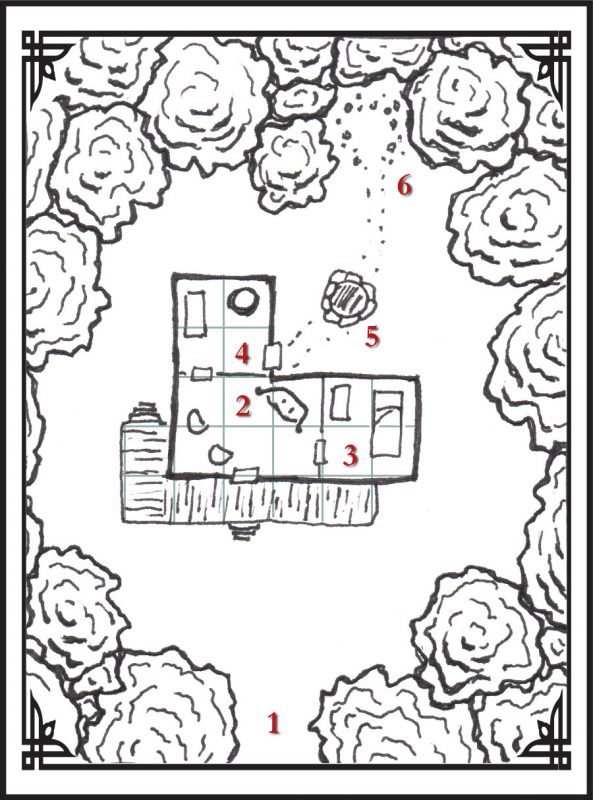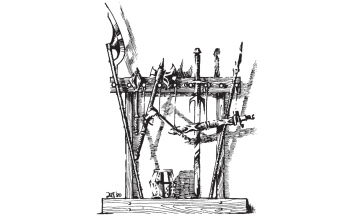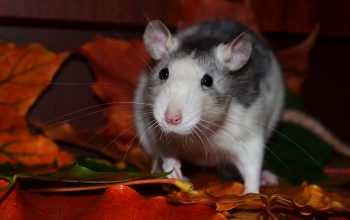
Well, I was supposed to be starting work on my first contract this morning, but due to the company shifting to remote work I find myself with a couple extra days off. Of course the whole reason for taking up contracting was to create a more flexible schedule to allow me to work on more TTRPG stuff, so I’m using the time to try and finalize my latest D&D adventure: Mirror, Mirror.

Mirror, Mirror is a 5e compatible D&D adventure placed in a fairy tale setting. King Nuno has summoned the party to track down the missing knight Sir Lucan, who vanished just as his nemesis, Zeroun the Enchanter, escaped from prison. The fate of the kingdom, and the happiness of Princess Ardella, lie in the hands of our brave adventurers, but not all is quite as it seems.
This fairy tale is marked by a cast of complex characters who turn classic fantasy tropes on their ear, and challenge the players to navigate intertwined NPC relationships and moral gray areas. There are plenty of locations to explore and enemies to vanquish, but all against the backdrop of a complicated web of conflicting NPC motivations. DMs must be ready to portray a variety of unusual characters and help their players navigate a plot that cannot possibly end with everyone living happily ever after.
I originally wrote this adventure way back in 2010 for HelgaCon and eventually ran it at GenCon in 2011, as well as TotalCon and Carnage on the Mountain 2014. Back then it was titled “To The Rescue!”, a title I was never really happy with, and now I’m glad to have found a better one that both references something specific in the game and evokes a little of the fairy tale setting. I started adapting my 5 pages of notes into a full fledged 5e adventure during the train ride to PAX Unplugged, and got much further along than expected thanks to getting stuck for 6 hours in New Rochelle. Since then though it’s been stuck on the back burner while I focused more of my creative time on streaming.
I chose this adventure to publish next because I wanted something really character focused after having done a fairly straight-forward dungeon crawl for The Vile Crypt. I thought it would be a nice change, and ideal for release on DriveThruRPG under the OGL license rather than DMs Guild, given how much of the text focuses on character background rather than game mechanics. I received some advice at PAX Unplugged that the best strategy was to release work on both sites and then cross promote between them. It seemed very smart advice and I’m glad to have the chance now to try it out.
The funny thing is, it turns out that the notes on this adventure were far looser than others I’ve written, as it really was just the minimal information I needed to deal with locations, monsters, etc. All the character interaction stuff was largely in my head, and I really needed precious few notes to recall it at the table. Trying to translate that into something another DM can read and run has been pretty challenging. I’m already at 20 pages, and I haven’t even created 5e stats for the NPCs yet – something I found in my last work that vastly increased the page count.

I’m also taking this opportunity to try and up the quality of my maps. My existing notes had several small custom maps rather than one large one as The Vile Crypt has, and I really want them to look nice on the page. So I read a bunch online of what techniques other artists use and then did my best to emulate them. Here’s a sample of a simple three room home set back in the woods that I’m pretty happy with. I found the key for me was first working in ink rather than pencil, and then adding a couple small details to every room based on the description I had already written. I feel like this really made the map come alive. I also spent a good chunk of time trying a bunch of different ways to draw trees until I found one I was happy with.
I have two more maps to draw (I’ve done six already), the stats of all the NPCs to create, the conclusion to write, and then I’m sure a dozen other small tasks and edits. It may be a little while before this thing is ready to post for sale, but the good news is that the design is solid and thoroughly play-tested, so all this just feels like so much assembly of existing parts. None of the work is particular hard, there just seems to be so much of it!
I’m sure you’ll be seeing more updates on this one as it progresses. I’d like to get it out of the way quickly to free myself up for other pending projects. All this time stuck in the house thanks to the coronavirus is sure to help my productivity on projects like this, so I guess that’s a silver lining of that situation?



Haha, I was thinking the description sounded familiar until I realized that I’d downloaded and read “To The Rescue!”. I don’t recall feeling like it was incomplete before. Can you give a teaser about what’s in those extra pages other than nicer maps? Did you feel the additions were more about addressing a lack of critical information or conveying a particular experience in play?
Fascinating. I had totally forgotten that I ever published anything about this one before. I did a little searching and came up with a post from April, 2010 when I talked about the adventure and posted my notes from that time. That would have been right after I ran it for the first time ever at HelgaCon 2010. I’ve since run it many more times including at three more conventions as well as several private games, and it has certainly changed a bit since that very early draft.
The biggest change that jumps out at me is how one-dimensional the characters feel in that early draft. In it the sorcerer is just plain evil (which perhaps implies that so is the princess?), the knight is just a jerk, and the king is actually barely mentioned. The witch is misunderstood by the locals, but her motivations are left pretty nebulous. As I recall, I had to improvise quite a lot around all these elements when running the game. There’s even mention in my original post about how I had forgotten to put any kind of time pressure on the situation and invented some brewing war, though I can see in the notes I posted I do mention the betrothal and additional suitors, which I think I added later to fit this requirement.
It is also interesting that I call it a “sandbox adventure”, which is basically true – there’s a bunch of locations and NPCs with specific motivations, but no direction on how events should unfold once the PCs get involved. That at least is something I have retained, though I sense from my writing in those 10-year-old notes that I was trying to leave things even more vague and have more open back doors to adapt the situation to what the players did. Eg, it doesn’t even say where the sorcerer is, and gives a couple options for choosing that on the fly. I think at the time I was targeting a 4-hour convention game, so was willing to place the sorcerer at whatever location the players went to first and then cut the other location entirely.
In the new text I’m assuming slower paced campaign play, and the possibility that the players explore the setting in its entirety. I’ve also devoted a lot of text to the background of the major NPCs. For example, I detail how the princess and the sorcerer met, and why the king would disapprove of their relationship. The sorcerer in fact comes across far more sympathetic, which creates a nice tension in the game. It starts out pretty starkly black and white, like a fairy tale, but as the players peel back the layers they discover how complex the situation is and will have to make choices on who they want to side with. There is no actual bad guy in this adventure, and the players are going to have to choose someone to disappoint by the end.
I’ve also filled in more minor NPCs for the players to gather information from – the captain of the guard at the palace, a few important villagers in Rylsk. For that matter I’ve added a lot more detail to the palace and the town of Rylsk, two locations I had to improvise every time I ran this because I failed to write anything about them in the original text. I also added more detail to the witch, as in practice pretty much every group chooses to talk to her rather than just skulk about her home. In fact you can see the map I posted above of her house is much smaller than the original one in my old notes. I’m still leaving a bunch of neat stuff in her house just in case the players choose to approach it as a B&E rather than a social call, though in practice I’ve never seen that done. But she’s now a more well rounded character, and could become either an ally or an antagonist, depending on how the players approach her.
Oh, and, as I stat things out I’m making it target lower level player characters. Given how much it focuses on social interaction over combat, I figured the power level kind of didn’t matter. I’m even debating putting in some different options for a few locations so it can be scaled to different player levels, but we’ll see how that works out when I get to it.
Haha, then I hope it wasn’t too creepy for someone to bring up something you’d forgotten about doing a decade ago :). The Internet can be a scary time capsule.
Thanks for the details of what you’ve expanded on and added since that draft. I’m very threadbare in my own preparation of character details, so it didn’t feel insufficient or one-dimensional to see someone described as “evil sorcerer, Chaotic, wants to be rid of pompous magical sword and flee with love”. The descriptions in “To The Rescue!” felt about the same length as what I did for the NPCs in my random village with a cult generator ( https://www.ashadler.com/single-post/2020/01/25/Random-Village-with-a-Cult-Generator-Inspired-by-Scenic-Dunnsmouth-Part-2 ), and those spun out into deeper characters quite naturally in my stream-of-consciousness follow-up working through two example villages. That all said, I’m probably in the minority on being comfortable with doing that level of character development on the spot.
It’s always fascinating to me to run an adventure multiple times and see what trends develop in the players’ behavior, though I haven’t run anything as many times as it sounds like you’ve done this one. I’ve got a 1-2 hour quickie about exploring a tomb/prison that I like using as an introduction to my way of handling dungeoneering. There’s a silver hammer in one room, suspending in a trapped gelatinous cube. There’s an altar with some broken statue fragments on it in another room. Everyone tries hitting either the altar or the statue pieces with the hammer, and I’ve never understood why (even when I’ve asked them about it afterwards, I’ve never gotten anything more than “it seemed worth trying *shrug*”).
Given the general ease of access to spells like Charm Person, ESP, Suggestion, Zone of Truth, Friends, etc. in D&D, I think there’s definite value in having a proper soap opera detailed to make a messy but believable explanation for a knot of social relationships. To go on a tangent, do you use any extra tools to help you keep the details straight? Relationship chart, a table of key bullet point, signature blurbs to capture the character, etc.?